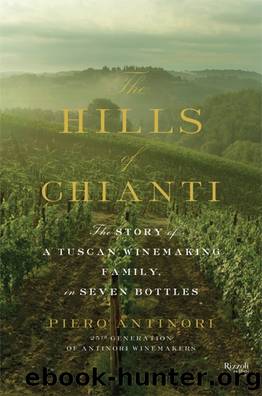The Hills of Chianti by Piero Antinori

Author:Piero Antinori
Language: eng
Format: mobi, epub
ISBN: 9780847844678
Publisher: Rizzoli
Published: 2014-09-02T07:00:00+00:00
Everyone was talking about the San Guido wine. Now there was a model to follow. There was a plan. And when our old, glorious Villa Antinori from 1970 turned out to be vastly improved by the new processes used in the vineyards and the cellars that Peynaud had suggested and Tachis had implemented, we knew we should keep going. It was time to concentrate on the land. It was simple, really. Where could a great wine be made if not on the estate where our best Sangiovese had always grown?
Today, the estate where we spent our vacations for a half century is home to the Tignanello and Solaia vineyards. My daughters and I have learned so much about grapes there. It’s a place that was made for wine. Exposed to the sun from the southeast, three hundred fifty to four hundred fifty meters above sea level, with an incline and drainage that seem purposely engineered, Tignanello has the ideal rocky soil and the perfect climate. During the days, it’s warm enough to develop sugars in the grapes, and at night the temperature cools to preserve the acids and develop the aroma. My father worked long and hard to plant the experimental Cabernet grapes here in the postwar period and then used them in his Villa Antinori. We were going to do things right and follow his example.
We produced only twenty thousand bottles of an early experimental Tignanello from the 1970 harvest. Created using new methods for selecting and handling grapes, it was a Chianti Classico with Sangiovese grapes and small amounts of white grapes. An excellent Chianti Classico, I must say, but still a traditional one in many ways. We labeled it “Villa Antinori” and then added “Tignanello Vineyard” next to that to be more exact.
The next year we cut our ties with the past completely. We finally crafted a mix free of white grapes. We harvested fully mature grapes. We fermented them with repeated repassing, a technique that consists of pouring the underlying liquid over the cap formed by the skins in order to extract the greatest amount of noble tannins from them. After alcoholic fermentation, the wine was subject to malolactic fermentation under the guidance of Peynaud.
This second type of fermentation creates better conditions for the malic acid in the grapes to generate lactic acid through the activity of certain bacteria. Without getting into too much technical detail, this is a natural process that solves the old problem of elevated acidity in our traditional grape mixtures, resulting in more balanced wines that age beautifully. Then it was time to let it sleep in small 225-liter barrels of new oak for a couple of years. These were the famous barriques that Luigi Veronelli would later rename carati in Italian during one of his visits to Tignanello. Caratelli were the small barrels traditionally used in Tuscany for aging vin santo, so the term was appropriate. Once the wine was out of the carati, it would age in bottles for another year.
Download
This site does not store any files on its server. We only index and link to content provided by other sites. Please contact the content providers to delete copyright contents if any and email us, we'll remove relevant links or contents immediately.
| Buying Guides | Cellars |
| Champagne | Collecting |
| Spirits | Whiskey |
| Wine | Wine Pairing |
| Wine Tasting |
Whiskies (Collins Gem) by dominic roskrow(42206)
101 Whiskies to Try Before You Die by Ian Buxton(42173)
Whiskies Galore by Ian Buxton(40326)
Craft Beer for the Homebrewer by Michael Agnew(17445)
Right Here, Right Now by Georgia Beers(3497)
Not a Diet Book by James Smith(2721)
Water by Ian Miller(2580)
The Coffee Dictionary by Maxwell Colonna-Dashwood(2529)
Kitchen confidential by Anthony Bourdain(2305)
Coffee for One by KJ Fallon(2006)
Smuggler's Cove: Exotic Cocktails, Rum, and the Cult of Tiki by Martin Cate & Rebecca Cate(1979)
Beer is proof God loves us by Charles W. Bamforth(1919)
Superfood Smoothie Bowls: Delicious, Satisfying, Protein-Packed Blends that Boost Energy and Burn Fat by Chace Daniella(1901)
Talking as Fast as I Can by Lauren Graham(1828)
Bourbon: A Savor the South Cookbook by Kathleen Purvis(1790)
A Short History of Drunkenness by Forsyth Mark(1717)
Eat With Intention by Cassandra Bodzak(1686)
Cocktails for the Holidays by Editors of Imbibe magazine(1624)
Colombia Travel Guide by Lonely Planet(1607)
